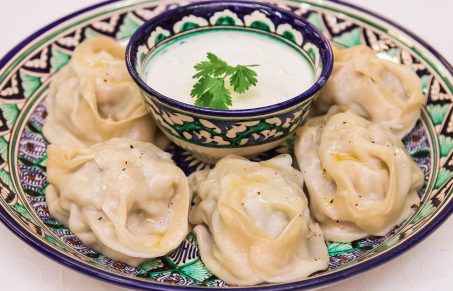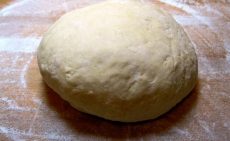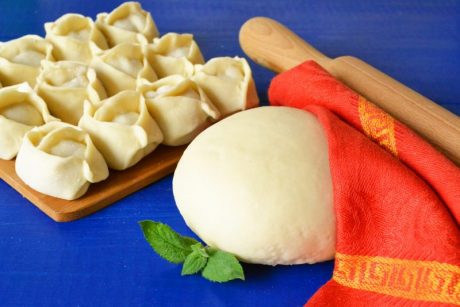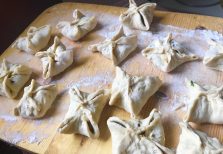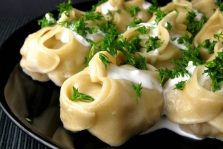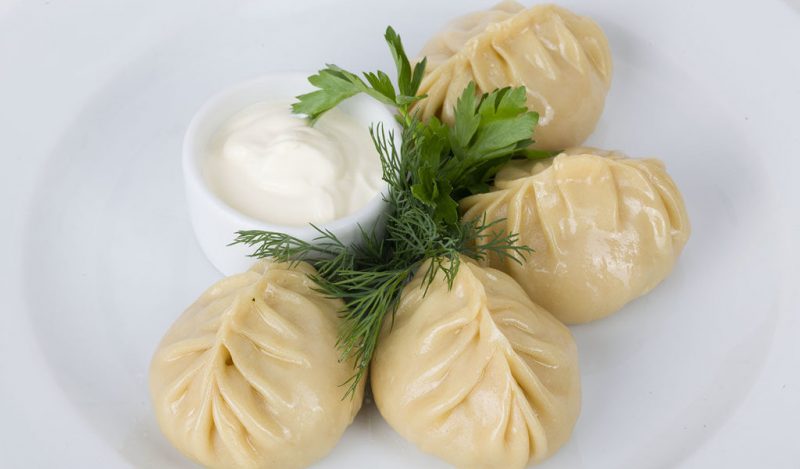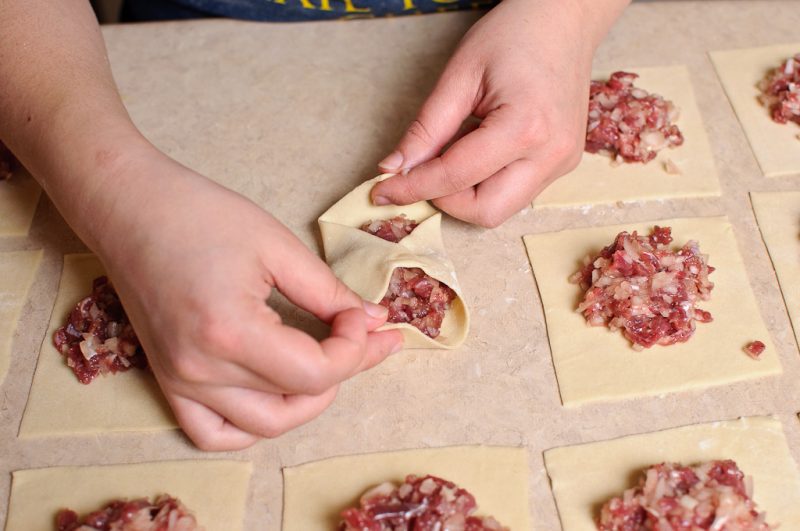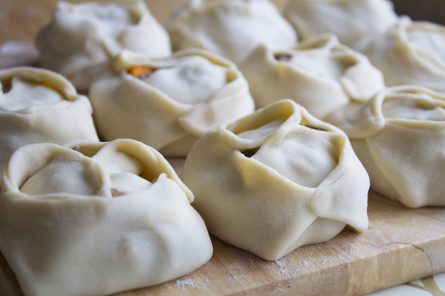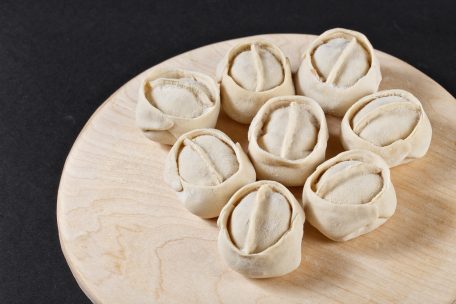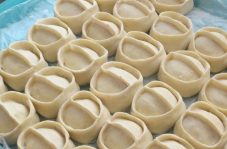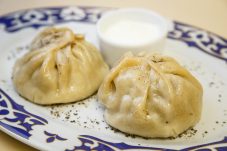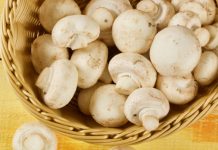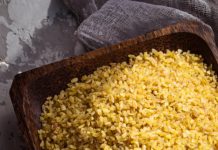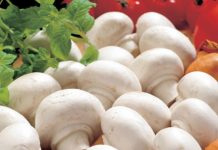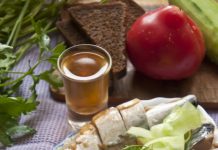Manti dough can be prepared in a variety of ways. Even the usual unleavened dough will turn out to be qualitative, if you adhere to the ratio of ingredients. Eggs, dairy products, different varieties of vegetable oil give their own special shades of taste.
Material Content:
Classic Manty Test Recipe
Many consider the classic version of the test simply on salted water, without fats and eggs. The rest prefer to add eggs to the water. Both options are good, but the texture, color and notes of taste are slightly different. The dough on the water does not have its own characteristic taste, so it is saturated with filling juices. Egg dough is slightly denser and has a yolk flavor. The first option (unleavened dough) is familiar to everyone, because it is the same as for dumplings. It is worth trying to cook egg dough.
Structure:
- pure warm water - 220 ml;
- flour - 500 g (+ 200 g for adding);
- eggs - 1 pc.;
- yolk - 2 pcs. (optional);
- salt - 15 g (to taste).
Stages of preparation:
- Prepare all components in advance.
- Yolks with eggs and salt are beaten for 0.5 or 1 min. until liquid texture without clots. You can use a whisk or a fork.
- Pour all the warm water into this mixture, stir well.
- The flour must be clean, high quality and carefully sifted. It is sprinkled in small parts, kneading the mass with a spoon.
- Rub the dough with a spoon so that there is no liquid left.
- Then knead the mass with your hands on a solid, well-fixed clean surface.
- It is necessary to provide a small supply of flour (about 200 g) in order to control the density of the dough.
- Stretch and fold the dough with an envelope, crushing it well (from 15 min.).
- The dough is elastic, smooth, without hard pieces. It does not stick to the surface and hands.
- Hands crush the dough from below to get a neat ball on top. From below, the folds will separate themselves during the “rest” of the test.
- Leave a lot of “rest” from 45 minutes. in a plastic bag.
- Next, you can start working with the finished test. Separate from the workpiece exactly as much as necessary for 1 rolling. The rest should not dry out. The dough is kept closed all the time in a bag or under a towel (which can be slightly moistened).
The dough is tender, tasty. It does not swell during cooking, does not break up, keeps its shape.
How to make Uzbek
A little oil is added to the Uzbek recipe, which makes the dough even more palatable, soft, elastic. It is pleasant to work with such a texture: the mass comes out supple, mixes well.
Structure:
- flour - 1 kg;
- cold purified water (but possible from a tap) - 0.4 l;
- salt - 1.5 tsp. (or adjust at their discretion);
- eggs - 2 pcs.;
- oil (any kind of vegetable) - 40 ml.
- Sift flour over deep dishes. So it becomes more oxygenated, airy. The dough will become softer.
- In the container, the dough is collected in a hill, a hole is made in it for liquid components.
- Chilled water (ice can be used) is mixed with salt and oil.
- Beat eggs in a separate plate.
- Eggs are gradually poured into the depression in the flour, and then water and oil are poured. Mix with a spoon the mass after the introduction of each small portion.
- Next, knead this blank with your hands (15 min).
- Elastic finished dough is carefully wrapped in cling film.
- The dough lies for 30 minutes. in the room.
When cooked, the dough is light but strong. The texture remains very tender.
On mineral water
Mineral dough turns out to be slightly more magnificent than usual and very elastic. Sour cream adds a light creamy flavor to the dough.

Structure:
- mineral water - 200 ml;
- sour cream - 100 ml;
- eggs - 1 pc.;
- flour - 800 g (and a little to add);
- salt - a few pinches (to taste).
Stages of preparation:
- Egg, salt, sour cream should have the same temperature (room temperature). They are well rubbed.
- Pour mineral water into the eggs, stir.
- Sift flour over the obtained liquid billet (you can sift a couple of times).
- Knead the dough first with a spatula, spoon. Then they massively pass the mass with hands for about 15 minutes.
- The dough is left to stand at room temperature (30 minutes is enough).
- Thanks to eggs and mineral water, the dough is a little suitable.
- The dough is ready.
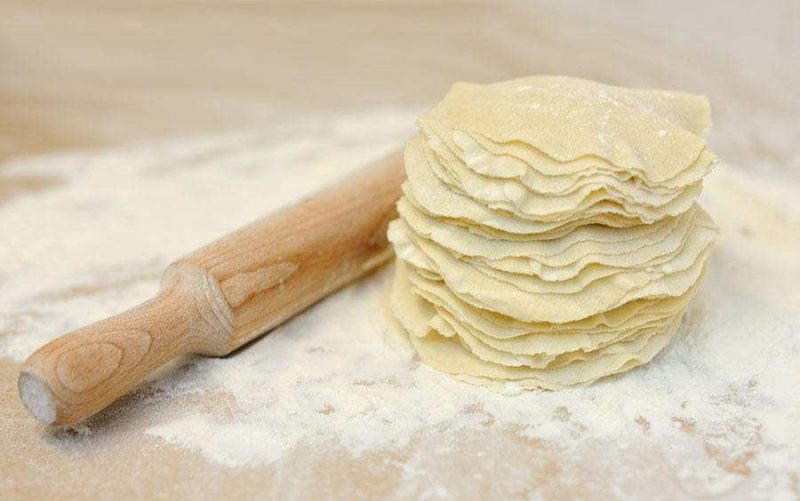 By adding sparkling water, they achieve a more magnificent dough texture.
By adding sparkling water, they achieve a more magnificent dough texture.
Manty dough in a bread machine
How to make a dough for manti without effort, but always with excellent results, the bread maker will “tell”. To prepare such a dough in a bread machine, you just need to fall asleep and pour all the ingredients into the device. The unit will quickly achieve uniformity and elasticity of the mass.
Structure:
- salt - 8 g;
- water - 150 ml;
- flour - 460 g;
- fresh eggs (medium) - 2 pcs.
- Pour dry ingredients (flour and salt) into the breadmaker's container.
- Break eggs into a container.
- Fill everything with water.
- Select the "Dough" mode.
- Different bread machines are kneaded differently, but on average it takes 15 minutes to knead.
- Take out professionally kneaded dough.
Such a dough is pleasant to work in, it does not stick.
If you choose the option “cook in a bread machine”, then this will facilitate the work. Thanks to the professional bread machine program, the dough always turns out to be smooth, uniform.
Lenten version without eggs
Many people call this dough "right." It holds its shape well, remains soft, tasty, not too dense. The main thing is experience in kneading the dough. This is what affects the correct consistency. This dough will boil well, but will not boil. Lenten recipe without eggs is in no way inferior to other versions of this test, if you adhere to the proportions.
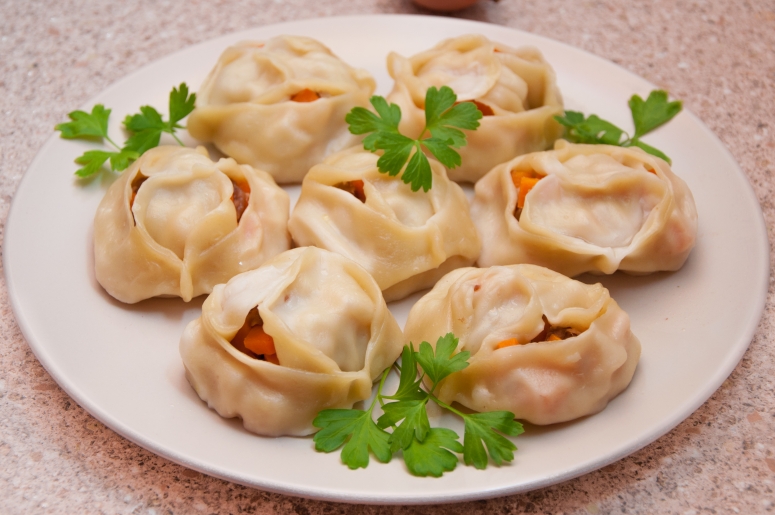 Structure:
Structure:
- vegetable oil - 25 ml;
- water - 240 ml;
- flour - 0.5 kg;
- salt - a few grams.
Stages of preparation:
- Flour is sifted over a deep bowl through a dense sieve, saturating it with oxygen.
- Salt is dissolved in water, oil is poured, stirred. The dough is strong enough, but not hard.
- Knead the dough for 10 minutes.Next him beat off on the working surface: raise low and throw strongly; turn on the other side and repeat again. After a few minutes, the dough will become more plastic.
- The resulting cake is left in a plate under a napkin (slightly damp towel).
- Leave the mass to "reach" for half an hour.
- Then they begin to work with the test.
This is one of the simplest and most proven options. The only danger is to learn to feel the correct consistency by adjusting the amount of dry and liquid products during kneading. Indeed, much is determined by the quality of the flour itself, the amount of gluten in it, its moisture. But this basic recipe, as a rule, does not fail.
Cooking in a custard way
Choux pastry can be rolled out as thinly as possible and it will not tear, it will remain elastic, but soft. Brewing makes it very tender, more transparent.
Structure:
- olive oil (or other vegetable) - 60 ml;
- salt - 6 g;
- flour - 400 g (+ 100 g to control the density);
- water - 200 ml.
Stages of preparation:
- Boil water.
- Water is salted.
- Pour oil into a liquid, stir.
- Remove boiling water from the stove.
- Introduce 200 g of flour (0.5 prepared for the recipe) in boiling water, stir.
- Lumps need to grind well, mix.
- Add the rest of the flour, knead for 10 minutes, periodically checking the uniformity of the mass.
- Allow the dough to stand in the film in the refrigerator for 30 minutes.
- The test preparation phase is completed.
If you prepare this type of dough for manti, the products will not fall apart, they will be especially tender.
Tender dough on milk
The dough comes out slightly milky in taste, strong, but soft. After cooking, the dough is juicy.
Structure:
- wheat flour - about 700 g;
- warm milk - 550 ml;
- vegetable oil - 90 ml;
- egg - 1 pc.;
- salt - 12 g.
Stages of preparation:
- Eggs, salt, beat in a light foam.
- Pour oil with milk, stir.
- Flour a couple of spoons, constantly stirring with a spatula (spoon).
- Actively knead the dough on the board for at least 15 minutes, so that it does not remain on the hands, the board.
- So that the dough does not have time to become covered with a dry crust, it is wrapped in a bag of polyethylene. It should stand at room temperature for 30 minutes.
- The formed dough is used in small portions, covering the rest with a piece of cloth or a towel.
The test has a pleasant “milky” color; it does not turn gray. Milk dough is considered classic, traditional.
Kefir Recipe
The color and taste of the "kefir" dough is slightly creamy. Due to the small amount of fat in kefir, the dough is soft, it rolls well into a thin cake.
Structure:
- kefir - 500 ml;
- soda - 6 g;
- salt to taste;
- flour - 600 g;
- vegetable oil (smell should be neutral) - 65 ml.
Stages of preparation:
- Kefir (better than room temperature) is poured into a working container.
- Kefir is salted, oil is poured.
- Flour is sifted over the kefir billet and stirred.
- The minimum time for mixing the mass is 10 minutes
- If there are no lumps in the mass, it ceases to stick - the dough is ready.
- Cover the dough ball with a film for 20 minutes.
Kefir dough is one of its most delicious varieties. Such a dough is considered universal. It is suitable not only for manti, but also for homemade noodle dumplings.
How to knead on yogurt
The dough with yogurt, kefir and sour cream turns snow-white even after cooking. His texture is very pleasant: strong, elastic, delicate. This recipe uses yogurt.
Structure:
- kefir of any fat content - 200 ml;
- high-quality flour - 320 g.
Stages of preparation:
- Sifted flour is gradually introduced into kefir.
- Stir the dough with a fork. It is convenient to use a fork to knead the mass at this stage.
- Knead on the table is not very tight dough.
- Allow the mass to stand for more than half an hour.
Such a recipe is convenient in that it has only 2 components. The dough does not even have to be salted: the acidity of yogurt will give a pleasant taste. Kneading the dough is quite easy, working with it is very comfortable. The mass is easily stretched, rolled.
The most important thing in the preparation of the test, which will be cooked, is to achieve the correct density, elasticity. This is a matter of experience, but if you follow the points of the described recipes, failure is unlikely.


